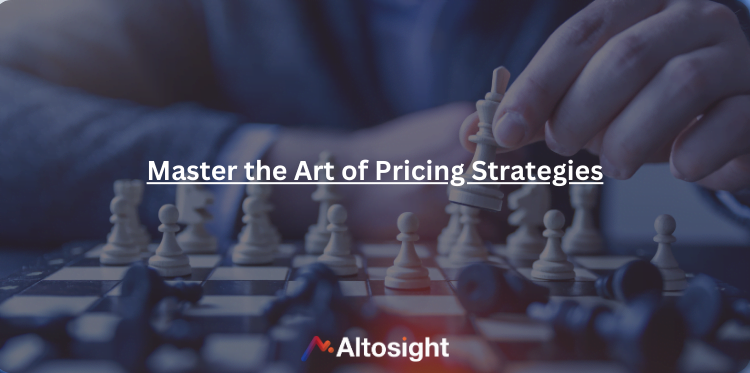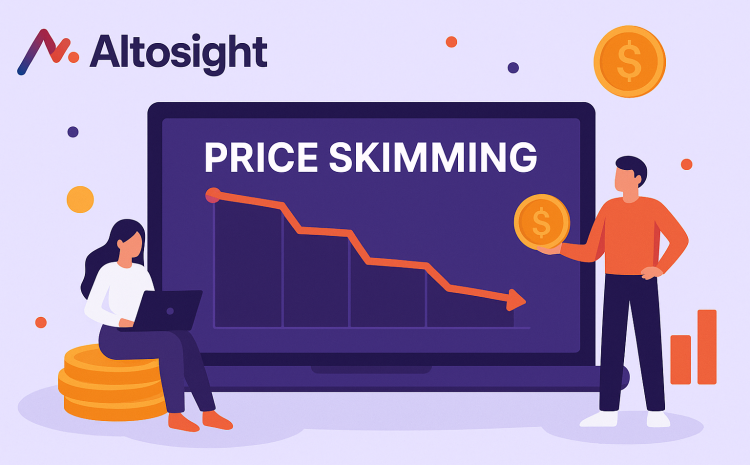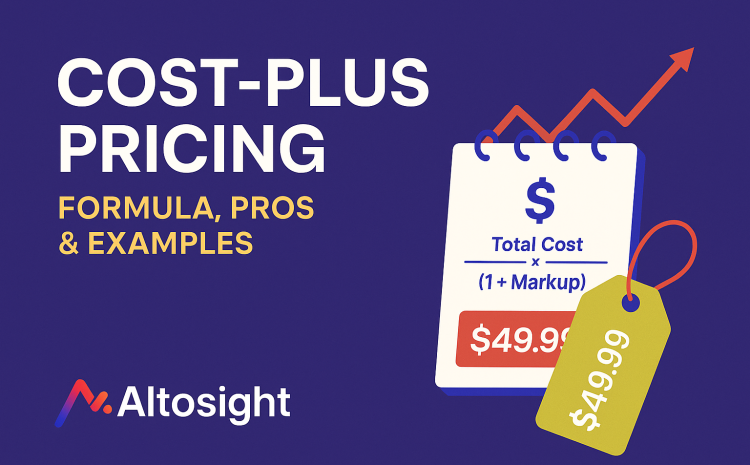
Pricing is a critical component of the marketing mix because it directly affects the profitability of a business and influences consumer behavior. Price your product too high, and you risk sales volumes and sitting inventory. Price it too low, and you’re leaving money on the table.
That’s why retailers and brands invest time and resources into developing the right pricing strategies for their products. But the right pricing strategy depends on many factors, including your market, product, demand, costs, and competition.
In this post, we’ll discuss pricing strategies, including their pros and cons, and when to use them. First, let’s understand the concept of pricing strategies.
The Concept of Pricing Strategies
A pricing strategy is a plan or set of guidelines retailers and businesses use to determine the most appropriate price for their products or services.
It involves considering production costs, market demand, competition, target customers, and perceived value to establish a price that meets business objectives. Pricing strategies help businesses achieve financial goals, increase revenues, and gain an edge in the market.
As a result, retailers need to price their products to ensure profitability and appeal to customers. It also shows that price determination is a continuous process.
What Factors Influence Pricing?
Before making pricing decisions, a business needs to consider the following factors:
Cost of the Product
Perhaps, this is the most crucial factor influencing the price of a product or service. The product cost typically includes the cost of production, but it can also include shipping, marketing, and overhead expenses. This will serve as the basis for calculating a selling price.
Suppose a company spends $10 to produce an item and $25 on promotion and distribution — that equals $35. Why? Because the company needs to cover the cost of production and promotion while making a profit.
In the short term, the business could initially price the product below the production cost to boost sales and gain market share. But in the long run, a company must adopt a pricing strategy that covers its cost of production while making a profit.
There are three types of costs for a company:
- Fixed costs are costs that do not change by using economies of scale. They are unrelated to the company’s activity or production level. They will still occur even if there are no sales or production. Some examples are salaries, rent, depreciation of equipment, etc.
- Variable costs change with the quantity of production or sales volume. These costs include materials, labor, order quantities, and variable overhead. Amounts vary based on output. For example, in a manufacturing plant, the cost of raw materials required to produce a product will drop if you order larger quantities.
- Semi-variable costs depend on the level of production and do not necessarily match directly. For example, a manager earning $8,000 per month and receiving a 10% commission on their sales becomes a semi-variable cost.
Market Demand and Supply
Demand and supply levels will also influence pricing decisions.
If demand is high, the business can charge a higher price, while low demand may necessitate lower prices to attract customers. For instance, the demand for essential products such as food or cleaning supplies doesn’t change much from price fluctuations.
Another factor to consider for market demand is the price elasticity of the products in question. Price elasticity measures how sensitive consumers’ purchasing behavior is to price changes. If the price is elastic, consumers will purchase lower quantities of the product if the price increases. If the price of the products is inelastic, then consumers’ purchase behavior won’t change much from a higher price.
Supply also plays a significant role because when supply is low, businesses can charge a premium price due to scarcity. Conversely, when supply is high, businesses may need to lower their pricing to remain competitive.
For example, when a new technology product is first released, supply may be limited, leading to high prices due to scarcity. As production increases and the product becomes readily available, prices may decrease due to increased supply.
Competition
Pricing also greatly depends on your competitors’ prices and how competitive your market is. If there are many competitors, a business may have to lower its prices, so they are more competitive. Conversely, a company can charge higher prices if there are few competitors and less supply.
Also, in a highly competitive market, having extras such as free or fast deliveries and coupons or additional guarantees can make your store stand out.
Branding and Positioning
A company’s branding and positioning strategy can also impact its pricing strategy. If consumers trust the brand and associate it with high quality, then they might be willing to pay higher prices in exchange for this.
This is because a higher price is usually perceived as an indicator of higher quality. Therefore, companies with strong brands often use premium pricing strategies to reflect the perceived value of their products or services.
Premium brands such as Apple or some major retail chains can charge higher prices due to their reputation.
Similarly, companies that offer niche products, such as free-range eggs, can often charge higher prices. Consumers associate these products with higher quality and are often willing to pay more for them.
In the case of free-range eggs, consumers may be willing to pay more due to their perceived higher nutritional value, as well as their humane and environmentally friendly production methods. By leveraging these unique selling points, companies can effectively differentiate themselves in the market and justify premium pricing.
On the other hand, mass market retailers such as Walmart or Target generally try to charge lower prices, be price competitive and sell high volumes of products.
8 Different Pricing Strategies and Examples
Choosing the right pricing strategy for your business is essential for profitability and company growth. You must ensure your price covers your costs, is competitive, and appeals to your target market.
Here are 8 of the different pricing strategies you can use.
1. Cost-based Pricing
Cost-based Pricing or cost-plus pricing is a pricing strategy where the price of a product or service depends on the cost of production plus a markup for profit. Production costs in this case usually include labor, materials and overhead.
Many businesses use this common pricing strategy, especially in manufacturing or production.
Example: If the cost of producing a product is $10, and the markup is 50%, the price would be $15. This way, the business makes a profit of $5.
Pros
- Easy to calculate and understand
- Ensures that the product or service is profitable
- Utility from having minimum prices per product to avoid selling at a loss
Cons
- It doesn’t take into account market demand or competition
- Inflexible, thus it may not result in an optimal price for the product or service given the market conditions
- If production costs increase, for whatever reason, it might affect pricing
Another variant of Cost-based Pricing is Marginal cost pricing.
In Marginal cost pricing, a company sets the price of its product or service based on the marginal cost of producing an additional unit. This strategy is often used by companies that have high fixed costs and low variable costs, as they can afford to sell their product or service at a low price as long as it covers their variable costs.
For example, a software company like ours might have high fixed costs related to developing the software, but low variable costs related to distributing it.
In this case, the company might price the software at a relatively low price point that covers its variable costs but still generates a profit.
2. Competitive-Based Pricing
With competitive-based pricing, a business sets its prices based on the prices charged by its competitors in the same market. The aim is to price a product or service in a way that is competitive enough to attract customers but still profitable for the business.
For instance, if a retail store sees a competitor selling the same product at a lower price, they may lower their prices to match or beat the competitor.
Pros
- It helps the business remain competitive in the market and in price comparison engines
- Ease of implementation as businesses only need to monitor their competitors and their minimum price per product so they don’t sell at a loss
- Can gain market share by selling the same product at a lower price than the competition, thus attracting price-sensitive customers (see 8. Penetration Pricing)
Cons
- It can lead to price wars and decreased profitability for both the business and the competition
- The potentially limited upside for both the business and the competition, as it might make it harder to increase prices later
- Tends to overlook unique value propositions, as the main differentiator is the price and not customer service, loyalty programs etc.
3. Value-based Pricing
Value-based pricing is a pricing strategy in which a business sets its prices based on the product or service’s value to the customer. The goal is to price the product or service at a level that reflects its perceived value to the customer rather than just its production cost.
A good example of value-based pricing is the luxury car industry. Luxury car companies often price their products based on the perceived value of the car’s brand and its associated benefits.
Another example is some service-based companies, such as lawyers or consultants, who price their services according to the benefit they provide to their clients.
Pros
- It can result in higher profits for the business
- Takes into account the perceived value of the product or service in the market
- It can help with company differentiation as the pricing focuses on the company’s unique benefits and its customers, instead of competitor prices
Cons
- It can be difficult to determine the perceived value of the product or service
- It may not be effective for all businesses
- Difficult to adjust and implement
4. Price Skimming
This pricing strategy involves setting an initial high price for a new product or service to maximize profits during the launch period when demand is high. Over time, the price is gradually lowered to attract more price-sensitive customers.
The technology and video game industries are good examples of industries that use price skimming. For example, game developers often launch new games at a premium price point to capitalize on the hype and demand surrounding the launch.
After a few months, as demand decreases and the market becomes more saturated, the price is gradually lowered to attract more customers.
Pros
- Price skimming can result in higher profits for the business in the early stages of a product launch
- It can create a perception of exclusivity and high value for the product or service
- Creates a buffer for future price reductions without hurting its price margins too much
Cons
- It may limit the market adoption of the product or service, as some customers will wait for the price to drop before buying it
- It can create a negative perception of the business if the price is too high compared to the final product
- If a competitor can jump in with a similar product at a lower price, they might steal some market share or customer base
5. Dynamic Pricing
Dynamic pricing is a pricing strategy in which the price of a product or service is adjusted in real-time based on various factors such as supply and demand, customer behavior, and external factors like competition, weather, or holidays. The goal is to find the optimal price that maximizes revenue and profit for the business.
Ecommerce stores usually adopt dynamic pricing by using price monitoring tools such as Altosight.
They set their re-pricing rules based on a number of factors such as competition, product base price + % product margin and other factors and the repricer does the work for them.
Also, airlines often use dynamic pricing to adjust ticket prices based on factors such as time of the day, day of the week, holidays, and how full the flight is.
Pros
- It can result in higher profits for the business
- Allows the business to respond to changes in market demand in real time and capture a bigger market share
- Remain competitive even during market and competitor changes
Cons
- If customers feel like they are being charged unfairly high based on arbitrary rules or very high demand, it might hurt the brand’s reputation
- It can lead to price wars which might end up suppressing everyone’s profit margins
6. Premium Pricing
Businesses use premium pricing to convey the message of high quality, exclusivity, or luxury by setting high prices for their products or services. The goal of premium pricing is to position the product or service as a high-end option and attract customers who are willing to pay more for high quality or luxury.
One good example of premium pricing is the luxury car industry. Companies like Rolls-Royce, Bentley, and Ferrari set premium prices for their cars to position them as exclusive and luxurious options.
Customers who purchase these cars look for the best quality, craftsmanship, and features and are willing to pay a premium price.
Another example is high-end apparel brands such as Gucci, Prada and others.
Pros
- Businesses can charge higher prices for their products or services, resulting in higher profits
- It can help a business differentiate itself from competitors and establish a unique market position
- Very little price competition if at all
Cons
- Premium pricing may limit the potential customer base to only those who are willing and able to pay the high price, reducing the overall market size.
- It can backfire if the product or service does not live up to the high expectations set by the price, which can lead to customer dissatisfaction and negative reviews
- The brand image, marketing and overall experience and product quality must meet a certain level in the eyes of the customer to justify the higher prices
7. Anchor Pricing
This is a pricing strategy where a business displays a higher-priced product next to a lower-priced product to make the lower-priced product seem like a better value. This strategy is often used in retail environments.
For example, a restaurant might have a couple of really expensive bottles of wine as an anchor to make their other wines look more affordable.
Pros
- Anchor pricing can incentivize customers to consider and purchase a higher-priced product that they may not have initially considered
- It can increase sales and profits for the business as the customer might feel more confident in their purchase decision by comparing the product they buy to the anchor
Cons
- It might lead the customer to confusion if they are not familiar with the anchor product
- It can lead to limited product development because if the company wants to introduce a much cheaper alternative, it might dilute the anchor’s value
8. Penetration Pricing
This is a pricing strategy where a business sets the price of a product or service lower than the competition to attract customers and gain market share. This strategy is often employed by new products or businesses.
One example of this is the gaming console industry. When Microsoft released its first Xbox console in 2001, it cost $299. This was significantly lower than Sony’s PlayStation 2, which sold for $399 then.
By undercutting its biggest competitor, Xbox was able to quickly capture a good portion of the gaming console market share.
Another example might be a new ecommerce store that sells most of its products lower than the competition to gain some market share, reviews and traction.
Pros
- Attracts new customers and grows your customer base. More customers should be willing to try a product at a lower price
- It might deter competition. If the competitors are more established or with lower profit margins, they might not want to reduce their prices
- Improves word-of-mouth, as word tends to spread around for good value-for-money products and services
Cons
- Lower % profit margins per sale
- Low prices may not be sustainable in the long run and it might be hard to raise prices later
- It might attract price-sensitive customers who might jump to a competitor if they are offered a lower price
The Bottom Line
Pricing strategies will require trial and error and reevaluation over time. However, by understanding the pros and cons of each strategy, businesses can better position themselves for success.
With price monitoring, you can make better pricing decisions based on actual data. Price monitoring lets you keep track of the competition’s price changes, campaigns, and stock levels in a specific market.





